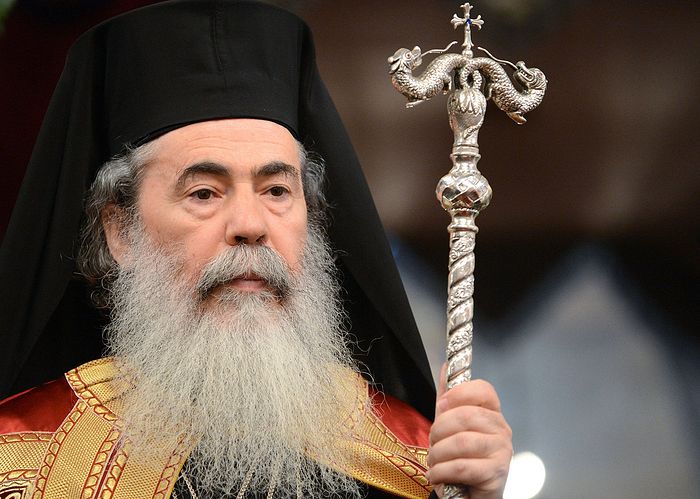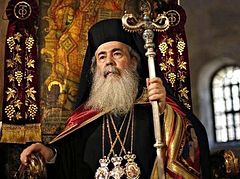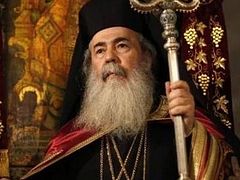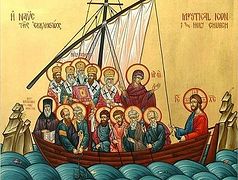How close are the ecclesiastical-historical ties between Ukraine and the Patriarchate of Jerusalem? Does the Jerusalem Patriarch have the right to call a Synaxis on the issues of Ukrainian Orthodoxy? Concerning these issues, the editors of the [Ukrainian] portal Pravlife.org asked church historian, Director of the International Institute of the Athonite Legacy in Ukraine, and the director of the Center for the Study of the Heritage of the New Martyrs and Confessors of the Twentieth Century, Sergei Viktorovich Shumilo.
—Recently, in some media outlets, one can find derogatory accusations against the Patriarchate of Jerusalem, as if calling for the council in Amman exceeds its authority, etc. How reliable and justified are these arguments from a historical point of view?
—This is not true. It is possible to have a different opinion about the Conference in Amman, but denying the right of the Patriarch of Jerusalem to initiate such an event is wrong. Among the Catholics, for example, the right to convene and bless councils and meetings is held exclusively by the Pope. But in Orthodoxy there is no Papism. Therefore, in principle, any Local Church can initiate such conferences and meetings, especially when it comes to the most ancient Church of Jerusalem, which from ancient times throughout the Orthodox world, has been revered as the “Mother of all Churches.” After all, it was there, in Jerusalem, that Christ preached, was crucified, showed the world the miracle of the Resurrection, and ascended. And here, at Pentecost, the Church of Christ was founded. The first Apostolic Councils were also held here, laying the foundation for the organization of the Church…
The most famous of these Jerusalem Apostolic Councils, which is described in detail in the New Testament, took place around 49 A.D. At that time, the Apostles made a historic decision to reject the circumcision of non-Jewish converts, as well as to refuse animal sacrifices, Levirate marriage, and various other Old Testament rites and rituals. All of this is recorded in the message of the Council, addressed to the first Christians of Antioch, Syria and Cilicia.
— And in later times, were there any Councils of general Orthodox significance in Jerusalem?
— Yes, there are many such examples. The most striking historical precedent for the convening by the Patriarch of Jerusalem of such a Pan-Orthodox Synaxis, was the Council of Primates of the Eastern Churches in Jerusalem, in April 1443. An Orthodox Council was held then in Jerusalem, at which the Ferrara-Florentine Union of the Patriarchate of Constantinople with Rome was condemned. This Council was convened on April 6, 1443 and was chaired by Patriarch Joachim of Jerusalem (1431–1450), and with the participation of the Patriarch of Antioch Dorotheus (1435–1451), and the Patriarch of Alexandria Philotheus (1435–1459). Also, the Metropolitan of Caesarea of Cappadocia and Exarch of all the East Arsenius from the Church of Constantinople took part, among others.
The reason for the convening of the Council was the appeal of the hierarch of the Patriarchate of Constantinople, Metropolitan Arsenius, to the Eastern Patriarchs, due to the appointment in various dioceses of Uniate Bishops by Patriarch Mitrophan of Constantinople. Unable to appeal to his Patriarch, Arsenius turned to the Council of Eastern Patriarchs.
At the Council, several definitions were compiled and approved, which condemned the Ferrara-Florentine Union of the Patriarchate of Constantinople with Rome, and also condemned the Uniate Patriarch Mitrophan II (1440-1443) and all hierarchs who accepted the union.
By the decision of this Council, the “Council of Florence” held in Italy by the Constantinople and Latin hierarchs was declared “odious, foul” (μιαρά), and the hierarchs and other clergy who received the ordination from the [Uniate] Patriarch of Constantinople who had ceased from Orthodoxy were declared “idle and unholy… from henceforth their piety is investigated in a general and ecumenical way [and found lacking].” Also, Metropolitan Arsenius, as a “preacher of piety and Orthodoxy,” was authorized by the Jerusalem Pan-Orthodox Council to notify the entire ecclesiastical completeness of Orthodoxy of this decision, ordering him to “henceforth preach piety everywhere, not fearing the Emperor, nor the Patriarch, or anyone else who doesn’t glorify that right.”
—Is this the only example of such a council in Jerusalem in the post-apostolic period?
— No, in fact, there are many examples from church history. Within the Church of Jerusalem there were many such Councils; to tell about all of them, one would have to write an entire dissertation. For example, in the first centuries of Christianity, in 190, the Jerusalem Council was held, which tried to resolve disputes about Pascha and determine a common date for all Christians to celebrate Pascha. In 393, the Church of Jerusalem held a Council in Caesarea of Palestine, which examined the dispute over the canonical election of the Patriarch Flavian of Antioch (381–404), whose legality was disputed by the Roman throne. The dispute was of a general Christian character, and the Church of Jerusalem firmly objected to the Church of Rome, deciding to recognize and commemorate Bishop Flavian as the only Primate of the Church of Antioch.
In 415, Patriarch John II of Jerusalem convened a Council, which considered the accusations from the Spanish (Galician) presbyter Paulus Orosius, regarding the teachings of the monks Pelagius and Celestius, who in the Roman Church were in dispute with St. Augustine of Hippo. And in 453, the Jerusalem Council was convened by Patriarch Juvenal of Jerusalem, condemning the robber’s resolutions of the Robber’s Council of 449 in Ephesus, which was held under the chairmanship of the Patriarch of Alexandria Dioscorus, who fell into monophysitism.
Another famous Jerusalem Council was in 513, at which the Monophysite heresy which prevailed at that time in Constantinople and Byzantium was condemned. The Byzantine emperor Anastasius (491–518) was then a supporter of monophysitism. Under his influence, monophysitism began to prevail in the Church of Constantinople, and in the Church of Antioch, the monophysites, with the support of the authorities, staged a coup, and overthrew the legitimate Patriarch Flavian II, who refused to accept this teaching. Therefore, the Council held in Jerusalem condemned the new doctrine and disorder that took place in the Local Churches, sending a message of protest to the Byzantine emperor Anastasius.
Here is another example: a Council in Jerusalem was held in 764, at which the Patriarch of Jerusalem Theodore (735–770), together with the Patriarch of Alexandria Cosmos (727–765) and Patriarch of Antioch Theodore, condemned the iconoclastic heresy, and confirmed the acts of the six Ecumenical Councils. Another “Pan-Orthodox” Council in Jerusalem took place in 836, which, in addition to the Jerusalem Patriarch Vasily (820–838) who convened it, was attended by Patriarchs of Alexandria Christopher (817–841) and Antioch Job (813–843), as well as many monks from different monasteries. The council condemned the iconoclastic heresy and sent a message to the Byzantine emperor Theophilos of Constantinople, in defense of the veneration of icons, which was included in the codex of official Orthodox conciliar definitions.
One can recall the “Pan-Orthodox” Jerusalem Council of 1522, convened by the Patriarch of Jerusalem Dorotheus II (1506-1537). The Patriarchs of Constantinople Jeremiah I (1522–1545), Alexandria Joachim (1487–1567) and Antioch Michael IV (1523–1529) took part in its work. At this Council, the seizure of the Patriarchal throne of Constantinople by Metropolitan Joannicius I of Sozopolis in Thrace was condemned.
In 1672, the Jerusalem Patriarch Dositheus II (1669-1707) convened a Cathedral in Jerusalem, in which representatives of other Local Churches took part. The Council approved the Orthodox Confession of Faith in 18 chapters, which later became an important doctrine document of the entire Orthodox Church. At the Council, the Protestant [and Calvinist] distortions in the Confession of Faith, published under the name of the Patriarch of Constantinople Cyril (Lukaris), were refuted, and the Orthodox Confession of Metropolitan St. Peter (Mohyla) of Kiev and Galicia was redacted and supplemented. The Jerusalem Council also found erroneous the decision of the Council of Constantinople in 1638 on the anathematization of Patriarch Cyril (Lukaris).
As we see, the Patriarch of Jerusalem in exceptional cases has the right to convene Councils and conferences, which often were considered to be "Pan-Orthodox" in nature.
— In some media, you can find accusations against the Jerusalem Patriarchate, as if by raising the Ukrainian issue at a meeting in Amman, he intervenes in the affairs of a foreign Local Church. How historically sound are these allegations?
— Again, it all depends on how you look at these issues. In fact, the fate of Ukraine and Ukrainian Orthodoxy has historically never been foreign to the Patriarchate of Jerusalem. It is enough to recall that the Apostle Andrew the First-Called preached in our lands1, and came precisely from Jerusalem. Inheriting this tradition, the Patriarchs of Jerusalem for a long-time exercised jurisdiction over the Crimean, Black Sea, and Scythian lands. The first missionary bishops known to us, Vasily and Ephraim, who founded the Local Churches of Chersoneses and Scythia, arrived here from Jerusalem in 310 in Tauroscythia2. A little later, the Patriarch of Jerusalem Ermon (Hermon), sent three more missionary bishops there—Evgenios, Elpidius and Agathodoros, who found the Local Churches of Phoulloi, Bosporus, and Phanagoria (Tmutarakan). Even during the time of Emperor Constantine, the Jerusalem Patriarchs took care of our lands and sent their bishops here. The Tauroscythian dioceses were deprived of their autocephaly and the patronage of the Patriarchs of Jerusalem only in 451, at the Council of Chalcedon.
— Are there any similar examples of the close ties of the Ukrainian Church with the Jerusalem Patriarchate in later times?
— Yes, of course. The year 2020 marks exactly 400 years since the restoration of Orthodox hierarchy in Ukraine by the Patriarch Theophanes III of Jerusalem.
As is known, after the Union of Brest in 1596, the Metropolitan of Kiev Michael Rohoza and almost the entire Orthodox episcopate within the Polish-Lithuanian Commonwealth adopted the union with Rome. By the early 1620s, The Orthodox Kiev Metropolia remained widowed for 24 years, and only one (Orthodox) Bishop in all Ukraine and Belarus remained—Bishop Jeremiah (Tyssarovsky) of Lviv.
After the episcopate transferred to the union, the Catholic authorities of the Commonwealth believed that the Orthodox Church in the country had ceased to exist jurisdictionally. However, the movement for the revival of Orthodoxy was led by simple priests, monks and the Cossacks. At the request of the Hetman Petro Sahaidachny and the Zaporozhian Cossacks, the Patriarch of Jerusalem Theophanes III traveled to Ukraine in 1620, and in secret from the Polish authorities, conducted episcopal ordinations, thereby restoring the Orthodox hierarchy in Ukraine and Belarus.
The first episcopal consecration by the Patriarch of Jerusalem Theophanes of Jerusalem was carried out on October 6, 1620 on the abbot of Mezhyhirya Monastery, Fr. Isaiah (Kopynsky), who was consecrated by the Patriarch of Jerusalem as bishop of Przemyśl and Sambir. In addition to Patriarch Theophanes, the Bulgarian Metropolitan of Sofia Neophyt and the Greek Bishop Abraham of Stagoi participated in this ordination. The ordination of Father Isaiah was carried out at night, in an atmosphere of strict secrecy, in the Epiphany Church of the Kiev Brotherhood Monastery in Podol. The liturgy was served almost in a whisper, and instead of the choir, there was the only singing of the patriarchal clergy; the windows of the church were shuttered and curtained so that none of the passersby noticed anything. Three days later, on October 9, in the same Epiphany Brotherhood Church, and in the same way, Father Job (Boretsky), the abbot of St. Michael's Golden-Domed Monastery, was secretly consecrated as a Bishop, who became the first Metropolitan of Kiev, Galicia, and all Rus’, after the Unia. Father Meletius (Smotrytsky) was also ordained as Bishop of Polotsk.
Later, in Podolia, guarded by Hetman Petro Sahaidachny and the Zaporozhian Cossacks, the Patriarch of Jerusalem Theophanes III secretly ordained three more Orthodox bishops: the former Athonite monk and abbot of the Cossack Trakhtemyrov Monastery Fr. Joseph (Kurtsevich-Koryatovich) was ordained as bishop of Vladimir and Brest; the former Athonite monk and abbot of the Chernchitsky Monastery Fr. Isaac (Boriskovich) as Bishop of Lutsk and Ostroh; and the abbot of the Myltsi Mykolayivsky Monastery Paisios (Ippolitovich-Cherkovsky) as the Bishop of Chełm and Belz.
The Catholic hierarchs and authorities of the Polish-Lithuanian Commonwealth then accused the Patriarch of Jerusalem of interfering within the boundaries of another Local Church, and the Polish authorities declared him a "foreign spy." Whatever the case, it was the Jerusalem Patriarchate that restored the episcopate of the Ukrainian Orthodox Church 400 years ago.
—Does the medieval concept of “Kiev—the New Jerusalem” somehow relate to these events?
— It arose much earlier, even in the days of the Grand Prince of Kiev Yaroslav the Wise, among the Kiev Caves scribes who tried to justify the independence of the Kievan Church from Constantinople. For the first time, we see the comparison of Kiev with Jerusalem by the Kievan Metropolitan St. Hilarion (Rusyn) in his famous “Sermon on Law and Grace”. Following him, this idea was developed by Jacob Chornoryzets in his work “Memory and Praise to Prince Vladimir”. He displays in it the perfect formula: “Oh what wonder! For the Second Jerusalem on earth has become Kiev!”
With the decline of the statehood of Kievan Rus, for some time the ecclesiastical concept “Kiev—the Second Jerusalem” became forgotten. However, it was precisely the involvement of the Jerusalem Patriarch Theophanes in restoring the hierarchy of the Kievan Metropolia in 1620, that triggered a new revival of this ancient pious ideology of the Kiev Caves spiritual athletes.
The first post-Unia Orthodox Metropolitan of Kiev, Job (Boretsky,† 1631), states concerning the Kievan Church that she, unlike the Rome-centered union, “is [established] on the good oak, the foundation of the Zion’s blessing”, and calls its cathedra “the new Jerusalem of Rus’”. In his encyclical of December 15, 1621, Metropolitan Job urged all the faithful to again acknowledge “the God-saved city of Kiev, the Second Jerusalem of Rus’." In his other letters, the Saint calls Kiev “the shrine of the true Jerusalem,” “the modern restored shrine from Jerusalem,” and speaks of his cathedra as “the holy throne of the Metropolia of Kievan Jerusalem.” Athanasius Kalnofoyski also wrote concerning Kiev as the “Second Jerusalem” in his work, the “Teratourgema”, published in the typography of Kiev Caves Lavra in 1638.
It is symbolic that the successor of Metropolitan Job (Boretsky), the Metropolitan Hesachyst Isaiah (Kopinsky,† 1640), focusing on the need for independent spiritual and national development, addressed those who went together in union with Rome with these words: “The Church of God is crying bitterly that you have forsaken her. Is Rome greater than Jerusalem? Is it not [in Jerusalem] where our Lord accomplished our salvation with His Holy Blood? Is it not from there that the Faith of Christ spread throughout the whole world and reached Rome? Here the vicar of Jesus Christ is the Patriarch, and in Rome, the Vicar of the Apostle Peter is the Pope, here is the Tomb of Christ, and there is the tomb of Peter… Why is Jerusalem, the Mother of all the Churches neglected while you turn to Rome, why is Jerusalem lowered and Rome exalted?”
— After 1620, did Ukraine still have similar ties with the Patriarchate of Jerusalem?
—When Hetman Bohdan Khmelnitsky liberated Kiev in 1648, he was solemnly welcomed in the city by the Patriarch of Jerusalem Paisios, who arrived in Kiev specially to bless the Hetman and the whole Zaporozhian army for the struggle for national and religious liberation. It was the Jerusalem Patriarch who granted the Great Uprising spiritual and religious legitimization, which other hierarchs shied away from. The Patriarch of Jerusalem then declared Bohdan Khmelnitsky as “sovereign and hetman”, declaring him “Prince of Russia” and “the new Moses”, “the liberator of the Rus’ people, the new Constantine the Founder”.
Under the influence of the Patriarch of Jerusalem, the Hetman, along with the Cossacks, then came up with the idea of creating a holy league of Orthodox powers, under the influence of which the liberation movement from Ukraine would spread to Greece, Serbia and Bulgaria, after which the Orthodox peoples and countries, including with Holy Sepulcher in Jerusalem, would be freed from the Islamic yoke. Later Metropolitan Joasaph of Corinth arrived in Kiev from the Patriarch of Jerusalem—he also blessed Khmelnitsky for the struggle, and symbolically handed him a sword, consecrated on the Holy Sepulcher in Jerusalem.
This Holy Hierarch, sent by the Patriarch of Jerusalem, was appointed by Khmelnitsky as his spiritual adviser, and took an active part in national liberation events, martyrically giving his life for the freedom of Ukraine. On June 22, 1651, Metropolitan Joasaph during the battle of Berestechko blessed the Cossacks in the middle of the battlefield, inspiring them to stand for their native Orthodox faith, for which the Poles cut him down with sabers. In addition to Metropolitan Joasaph, Metropolitan Gabriel of Nazareth came to Hetman Khmelnitsky from the Patriarch of Jerusalem, and other clergymen tried to provide spiritual support to the Ukrainian people in their liberation struggle.
Later, the Metochion of Saint Catherine’s Monastery of Sinai was a kind of bridge that continued the spiritual and historical ties of Kiev with the Holy Land, which existed in Kiev, in Podol from 1748 to 1926 and was canonically associated with the Jerusalem Patriarchate. Under the communist regime, the Sinai Metochion was liquidated, and the church was blown up. Now on the premises of the former Sinai Metochion in Podol, a headquarters of the National Bank of Ukraine for Kiev and the Kiev region is located.
So, as we see, for many centuries Ukraine has had rather close spiritual and historical ties with the Patriarchate of Jerusalem, to which Ukrainian Orthodoxy has never been alien.




